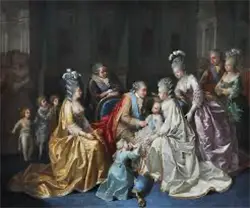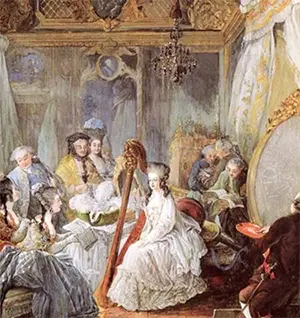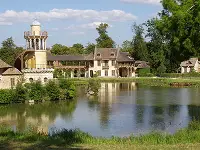Marie Antoinette
Part 1: From Princess to Queen Marie Antoinette was one of the most famous queens in French history. Known for her extravagance and her love of publicity, she also garnered much of the blame for the decline of French society and the widening of the divide between the classes that eventually led to the French Revolution. 
She was born Maria Antonia Josepha Joanna von Österreich-Lothringen on Nov. 2, 1755, at Hofburg Palace in Vienna. Her father was Francis I, the Holy Roman Emperor. Her mother was Maria Theresa, whose possible ascension to the throne had caused the War of Austrian Succession some years before. This Maria became known as Maria Antonia because her parents named all of their daughters Maria. 
Longtime enemies Austria and France signed an alliance in 1756, ostensibly to counter the growing might of neighboring Prussia. To cement that alliance, the monarchs of Austria and France agreed to a royal marriage, whereby Maria Antonia would marry the Dauphin, Louis, heir to the French throne. They were married on April 19, 1770. She was 14; he was 15. They married by proxy, finally meeting when she arrived in France on May 14 of that year. They were officially wed two days later at the Palace of Versailles. The French didn't much like the idea of their Dauphin's marrying an Austrian princess, particularly in the wake of France's disastrous results as Austria's ally in the Seven Years War, as the result of which France lost power and influence in Europe and a large amount of territory overseas. 
Furthering the discontent of many French people was the royal couple's lack of children. King Louis XV died on May 10, 1774, and the Dauphin became King Louis XVI. It wasn't until 1778 that the king had a child, and that child was a girl, Marie-Thérèse. King and queen eventually had four children, two sons and two daughters. Louis-Joseph was born in 1781, and Louis-Charles was born in 1785. A second daughter, Sophie, died in infancy. In many ways, Marie and Louis were opposites. He was an early riser; she was a night owl. He was at home by himself, making furniture and tinkering with locks. His shyness made him indecisive, with her and with his government. She craved attention and had no problem defending a decision that she had made, no matter how quickly she had made it. Marie spoke little French when she arrived but had been learning from a private tutor. She had had little formal education when she was young but was an intelligent child and learned much in the way of court life and could dance and sing and play music. 
She carried over that enthusiasm for entertainment into her new life as Queen of France. She was used to great wealth and the trappings therein. For her trip to France to marry Louis, she had an escort that included 57 carriages, 117 footmen, and 376 horses. She had exorbitant taste and raided the royal treasury to buy expensive clothes and jewelry and to throw elaborate parties. A talented harp player, she often entertained her guests long into the evening; as well, stories exist of her playing with and for famous musicians. One thing she particularly liked was to have her hair done in extravagant and showy ways. Her hair at times rose a few feet off her head. On one occasion, to mark a French naval victory, she had her hairdo include a large model of a French warship. Her extravagant spending did not go unnoticed, especially by those who could not afford the basics. A series or poor harvests in the 1780s resulted in a rise in the price of bread, which meant that some people had to go without. And yet, Marie, especially, but also others of the royal family and certainly some nobles carried on with their profligate spending. Perhaps the height of the disparity between Marie Antoinette and her subjects came in 1783, when she embarked on a period of construction for Le Hameau de la Reine ("The Queen's Hamlet"), a replica of a farming village that she had built on the grounds at Versailles, the royal palace. Next page > All Fall Down > Page 1, 2 |
|
Social Studies for Kids
copyright 2002–2025
David White



 Added to a farmhouse and cottages were the trappings of a peasant farming village, even down to a number of animals commonly found on farms at the time. Marie and her maids took to dressing up in peasant clothing and even doing the milking of the cows and sheep. Whatever the queen might have thought about why she was doing such things, the general public, especially the poor, considered her behavior to be mocking those who had nothing other than a farming life to keep them going. Inside the various farm cottages were comfortable furnishings.
Added to a farmhouse and cottages were the trappings of a peasant farming village, even down to a number of animals commonly found on farms at the time. Marie and her maids took to dressing up in peasant clothing and even doing the milking of the cows and sheep. Whatever the queen might have thought about why she was doing such things, the general public, especially the poor, considered her behavior to be mocking those who had nothing other than a farming life to keep them going. Inside the various farm cottages were comfortable furnishings.
